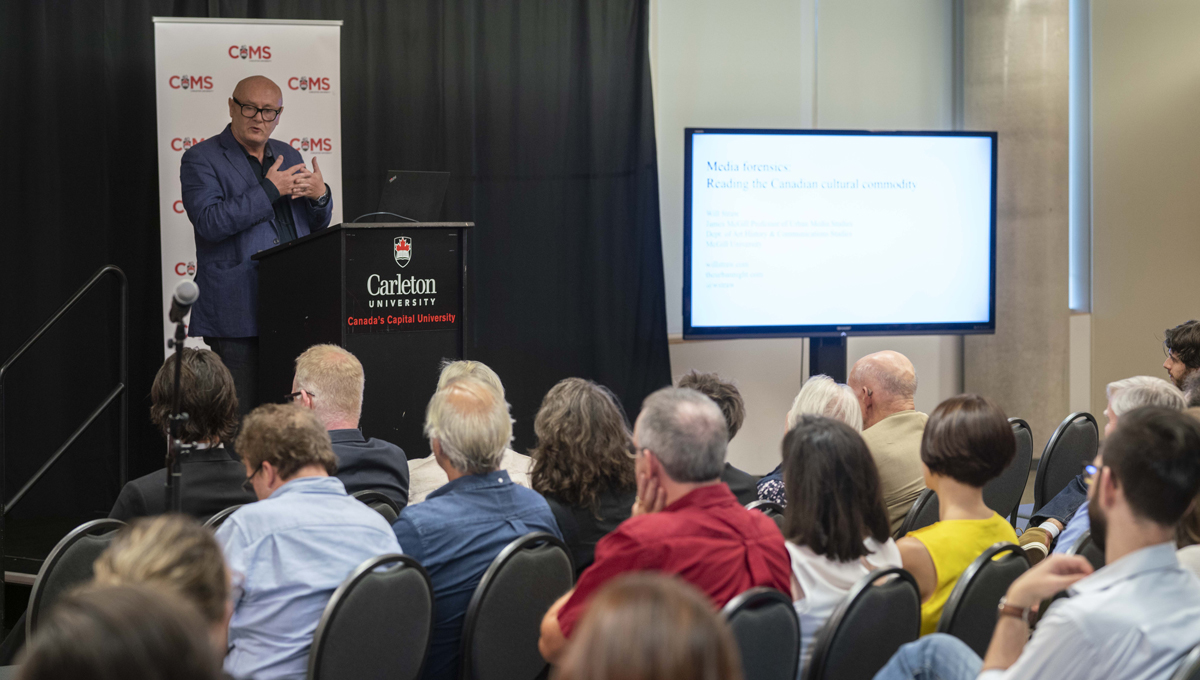By Joseph Mathieu
Photos by Chris Roussakis
Since the start of Carleton University’s Communication and Media Studies program, Will Straw was Paul Attallah’s friend and colleague.
So it was particularly fitting that Straw, the James McGill Professor of Urban Media Studies at McGill University, gave the 10th annual Attallah Lecture that kicked off the 40th anniversary of Carleton’s communication program on Sept. 6, 2018.
Named in honour of the former associate director of the School of Journalism and Communication, the Attallah Lecture sheds light on the current issues and themes in communication and media studies. Attallah, who passed away in 2009, exemplified some of the finest qualities of the program and of the discipline as a whole, said Straw as he began his lecture titled Media Forensics: Reading the Canadian Cultural Commodity.
Straw’s presentation brought together several of his research projects on magazines, music and films in an investigative light.

“We associate forensics with police work but of course it’s bound up with other kinds of traces and other kinds of knowledge as well,” he said.
From traces of data on abandoned hard drives to scanning streamed videos in search of stolen intellectual property, forensics and media go hand in hand in the digital age. But Straw’s lecture focused on analog media: true crime pulp magazines, film and disco records, examining how the objects were transformed in response to market conditions and the cultural landscape.
Exploring Canadian Pulp Magazines
Straw concentrated on the golden age of Canadian pulp magazines, when Toronto and Montreal publishers were putting out true crime, adventure and “spicy” (i.e. softcore pornography) magazines in the 1940s. This production began in earnest when the Canadian government restricted importation of American popular magazines in order to protect the Canadian currency during World War II, though they had been around as early as 1937.
Some magazines, like Canadian Tattler, Snappy Review and Intimate Confessions of Crime and Passion, were little more than repackaged American content from older magazines. Straw paused on slides that showed their covers and tables of contents to examine notes and markings that alluded to certain subterfuge.
“At these low levels of Canadian production we find a number of strategies at play,” he said. “One is genre masquerade, which packages a media product as something else.”
The lurid was disguised as respectable, and the respectable, like Gustave Flaubert’s Madame Bovary, could be made sensational with vaguely erotic drawings. Masking the date and location of publication also allowed less-than-virtuous peddlers to push their pulp on unsuspecting Canadians who paid twice the original price for plagiarized content.

Prof. Josh Greenberg introduces McGill Prof. Will Straw during the 10th annual Attallah Lecture.
Publishers aiming at some sort of respectability would date their titles to build up a continuity of readership and would advertise all-Canadian content. Less scrupulous publishers made no mention of month or year to sell them over longer periods of time and often filled them with old stories and images from American magazines.
Straw held up Famous Crime Cases, one of the longest-lasting Canadian true crime magazines, as one of the more unique artifacts in his research. Although it boasted all-Canadian content, its February 1949 issue announced the addition of 32 pages of comics on its cover without mentioning they were all American-made.
“What you have are fairly drab true crime stories about Hamilton, Ontario or Winnipeg bookending exciting colour U.S. comic book stories,” said Straw. As pulp magazines were falling out of favour and the popularity of comics rose, publishers like Famous Crime Cases included the new media form in their pages to stay relevant. Straw identified this hybrid commodity as the precursor to the placement of CDs or DVDs in the “failing” form of magazines in the early 21st century.
Famous Crime Cases could also be considered a Trojan horse, since progressive conservative MP Davie Fulton introduced legislation in the House of Commons in 1949 to render criminal the publication, distribution and sale of crime comics in Canada.
Digging into Canadian Vinyl and VHS
Straw primarily focused on pulp magazines and vinyl recordings, but also shone a light on the opening credits of a Canadian film rereleased on VHS in the United States under a different name. First titled Golden Apples of the Sun in 1971, it was rebranded as Caged Terror in 1973, and “a pastoral hippie exploration of cross-border differences [was] repurposed as a backwoods horror story.”
He also examined the career of Afro-Québécois musician Pierre Perpall, which exemplified the dilemmas facing musicians of colour in Quebec celebrity culture in the 1960s.
Perpall, born of white and black parents in 1948, could only succeed in show business by pretending to be African American. He fronted cover bands, playing French versions of American songs, until the end of the ‘60s, when Quebec pop music turned away from covers and performers were expected to write their own songs. Only by the 1970s, when disco began to take off in Montreal, was Perpall able to find another place in Canadian culture.
Like the golden age of pulp in the 1940s, the 1970s heyday of Montreal disco were both the result of minority cultures creating materials that were regarded as “low”. Pulp was mostly the work of marginal Jewish entrepreneurs, and in the ‘70s a large number of disco workers were Italian-Québécois and Latino-Québécois.
“Whereas pulp publishers disguised their materials to enhance their legitimacy . . . disco producers in the 1970s disguised their “Montreal-ness” to help them circulate more easily in international markets.”
The 12-inch dance singles moved around in generic white sleeves, a far cry from the visual culture of musical celebrity and detailed liner notes of rock albums. Like a detective, Straw poured over the clues about composers, artists, engineers, producers, distributers, and even the DJ owner of a record titled “Love Now Hurt Later.”

A Frienship Sparked at the Inception of the Communication and Media Studies Program
Attallah, who was head of the mass communication program from 1991 to 2005, would have loved the lecture, said Prof. Michael Dorland, not only because it brought together two things people rarely thought of together — media and forensics — but because it tackled the tricky subject of Canadian culture.
Attallah and Straw were also old friends. The pair met the same year that Carleton’s mass communication program launched, in 1978, both of them completing their master’s degrees at McGill. Here they spent two years in the same classes, and wrote their first conference paper together on television coverage of the 1980 Quebec referendum.
Before that, when he was 18, Straw came to Carleton University to study journalism but soon switched to film studies. He returned to teach in the film studies program at Carleton in 1984, and now teaches at McGill University in the Department of Art History and Communication Studies.
Big thank you to all our faculty, staff, students and guests, especially @wstraw and @shannonmattern for their brilliant public lectures to kick off our #COMS40 celebrations. Many more events to come this year — stay tuned!
— Communication & Media Studies @ Carleton (@CommStudies_CU) September 15, 2018
Instead of becoming a crusading journalist, Straw became a different sort of investigator in reading and interpreting media. He sought out clues about the conditions under which commodities were made, the pressures that shaped them and the calculations that directed their distribution.
Even with diverse forms of media and content from different corners of Canada, Straw pointed out the difficulty, if not impossibility, of identifying an essential idea of national identity by studying Canadian cultural commodities.
“As this is increasingly shown to be problematic and untenable, forensic analysis of media objects at least allows a fresh approach to the Canadian cultural commodity.”
Monday, September 17, 2018 in Communications and Media Studies, Faculty of Public and Global Affairs
Share: Twitter, Facebook



